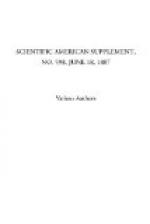is very considerably minimized, owing to the great
preponderance of white light, which overlies as it
were the colored rings. Even in the first instance,
as the lecturer was able to show later on, the colors
are not nearly so intense as they may be obtained,
owing to some white light being reflected from the
surfaces of the two sheets of glass. With regard
to the appearance of the phenomenon, it is observed
that the part which corresponds to the thinnest part
of the film is considerably darker than the rest of
the spectrum; around this is a bright ring of white,
succeeded by constantly increasing concentric rings
of different colors apparently repeating themselves.
Lord Rayleigh also obtained the same results with
a film of a solution of soap and glycerine, but in
this case the dark portion was observed at the top
of the spectrum, the other colors arranging themselves
in order in the soap film thinned by the force of
gravitation, thus showing that the colors vary according
to the thickness of the film. Another form of
the experiment called forth a considerable amount
of applause from the audience. Lord Rayleigh caused
a gentle stream of air to play obliquely upon a soap
film, so that the part struck was moved forward and
the whole film rotated. Then with the alteration
of the force of the current of air, which of course
regulated the centrifugal force, alternating thicknesses
of film were obtained, causing a varying display of
beautiful colors and combinations of colors.
This last experiment also tended to prove that the
bands of color are not arranged in a certain order,
but vary according to the thickness of the film, a
conclusion arrived at by Brewster, who observed that
if a film reflecting certain colors be carefully inverted
so as not to disturb the gravity, the colors reflected
are also inverted. Lord Rayleigh explained the
phenomenon by referring to Young’s wave theory
of light. He regarded the film as having two
surfaces from which light is reflected, an anterior
exterior surface and a posterior interior surface.
If a ray of light be thrown upon the film, a part
of the light is reflected from the first surface,
but the greater part is transmitted, and some of this
is reflected from the second surface, passes back
through the film, and is combined with the light reflected
from the first surface. If then the light reflected
from the second surface be in the same state of vibration
as that reflected from the first surface, the effect
of their combination will be to increase the amount
of light reflected from the first surface, but if otherwise,
the effect will be a partial neutralization of the
light reflected from the first surface. That
is to say, if the retardation of the light which is
reflected from the second surface, owing to its twice
traversing the thickness of the film, be equivalent
to a wave length of the vibration of the light, it
will increase the intensity of the light reflected
from the first surface. If, however, the retardation




